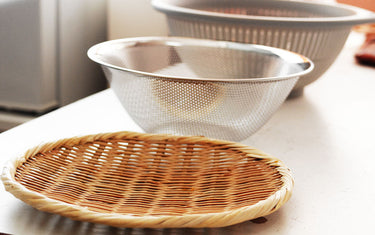Let us introduce how to select, care for, and store colanders.
We have tried these tools.
How to choose a colander
First, let us introduce how to choose a colander.
Choose by size

Colanders come in various sizes. Be sure to choose the appropriate size suitable for your use. For example, a colander with a large diameter and a deep bottom is easier to use for draining noodle dishes such as soba. On the other hand, if you want to serve rice balls or boiled vegetables for a lunch plate, a colander with a smaller diameter and a shallow bottom will be easier to use.
Choose by shape

Generally, most colanders are round shape, but there are also rectangular colanders and colanders with special shapes such as a dustpan shape. If you want use it for serving plated dishes, be design-conscious.
Choose by mesh fineness

Each colander has a different mesh fineness. The finer type has a high filtration function and can be used for puree, but it is prone to clogging and is difficult to clean. The mesh coarser type drains well and are easier to clean, but it doesn't have high filtration capacity. Take a look at the each features and choose the colander with the functionality that best suits for your use.
Choose by material

There are various types of colanders, including stainless steel, plastic, and bamboo. Choose the colander type based on the frequency of use and purpose. In the next section, we describe in detail the features and main use application of each material.
Features of each material
First, the features of colanders are described by material.
Made of stainless steel

Due to its strength, a stainless steel colander can be useful when it is pressed with force, for example, when make a puree.
It is also easy to clean by scrubbing with a scrubbing brush or other tools. Since stainless steel is a metal, it is not absolutely rustproof. However, another advantage of stainless steel is its rust-resistant unlike iron.
Furthermore, stainless steel can be cleaned using a chlorine-based detergent, making it keep clean. However, soaking with chlorine-based detergent is not allowed, as it may cause rusting.
Made of plastic

Plastic colanders are lightweight, easy to handle, and most importantly, inexpensive. This is the most important advantage. It is useful when multiple colanders must be needed for business use.
In addition, thanks to its color variations, each color can be used for different purposes and can be color-coded according to time of purchase to make the date order. It is the feature that various advantages can be utilized up to your ingenuity.
Another advantage would be microwave-safe largely.
Made of bamboo

The bamboo colander drains very well and has a wide range of uses. Another advantage of this product is that it can be used for processing with hot water because of its heat resistance temperature of 100℃ or higher. However, please note that although it is heat-resistant, it is generally not dishwasher-safe for drying.
How to care for each material
Made of stainless steel

Simple stains on the stainless steel colander can be removed simply by scrubbing with a Japanese scourer. If it's clogged with stains, fill a bowl larger than a colander with water and scrub the stains with a Japanese scourer dipping it in the water. Japanese scourer is recommended to use over a brush or sponge since it's easier to wash a colander.
If it's getting blackish, like getting rusted, some rust can be easily removed by rubbing with a tooth brush dipped in toothpaste. Since rust will spread if left untreated, take care of it as soon as possible.
Chlorine bleach is needed for serious stains. However, since chlorine bleach corrodes metal, be careful not to use it for a long time, even though it is a stainless steel. After using chlorine bleach, rinse it immediately and dry well.
Made of plastic

For plastic colanders, cleaning with a sponge using a mild detergent is basically sufficient. Since plastic is easily scratched, a soft sponge is recommended rather than a scrubber. Once it is scratched, bacteria can grow there leading to unsanitary.
Bleach is also recommended for cleaning plastic colanders. Unlike metal, plastic is not affected by bleach, so it should be soaked regularly to keep it clean.。
Since it is susceptible to high heat and shock qualitatively, the utmost care shall be taken.
Made of bamboo

In case that the bamboo colander is slightly stained, it is sufficient to wash it well under running water using a scrubbing brush. If stains like grease are on the surface, wash it with a sponge using a mild detergent. However, excessive use of detergents is strictly prohibited, as they may wash away even the natural components contained in bamboo. Rinse well after use.
If the mesh gets clogged, toothbrush or other brush is recommended for cleaning. Let’s master how to clean depending on the situation.
Besides, bamboo colanders can be disinfected with boiling water thanks to its heat-resistant. Disinfecting it regularly with boiling water can prevent the growth of bacteria.
Use the colander wisely
There are various types of colanders, each with its own advantages and disadvantages. Understand each characteristics of materials and shapes, so that we can use them wisely as useful kitchen tools.
















